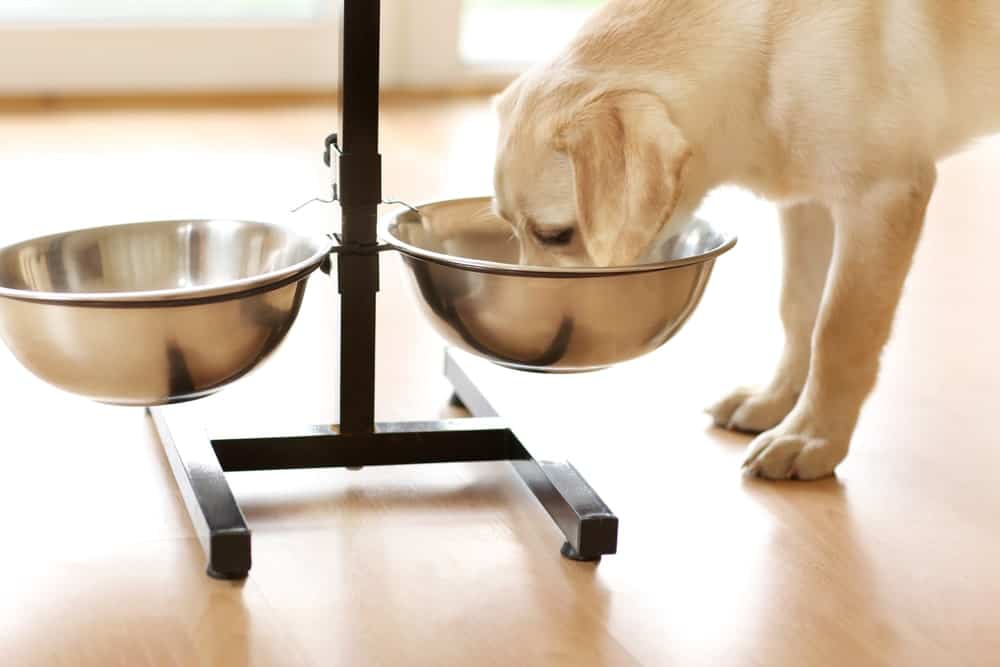“This post contains affiliate links, and I will be compensated if you make a purchase after clicking on my links.”
Pet owners all over the world use them, some veterinarians recommend them, and your dog may even seem to eat from them more comfortably—elevated food bowls seem like a logical choice if you have a large breed dog. However, pet owners who have dogs at risk of bloat are starting to shy away from elevated feeding, and there could be a really good reason.

What Is Bloat and Which Dogs Are Most Affected?
The Condition
What is referred to as bloat is actually a condition called Gastric Dilatation Volvulus (GDV) that some canines are prone to experiencing. GDV is actually not totally understood by veterinarians, but there are certain things that are understood about what happens when bloat occurs. In general terms, bloat occurs when a dog’s stomach twists and fills with gas, or it fills with gas to an extent that it causes a twist. In either case, bloat can be extremely painful for the dog and life-threatening if it is not immediately tended to by a veterinarian.
When not treated, GDV can cause the stomach to distend because it is filled with gas. Unfortunately, this can increase pressure against the diaphragm and make it hard for the dog to breathe normally. After some time struggling to breathe, the pressure can interrupt blood flow to the coronary system. Additionally, stomach rupture and spleen-damaging twists can occur, which causes some tissue to die. According to PetMD:
“These animals can become critically ill or die within hours if not treated,”
The Cause
What is not clear is precisely what causes a dog to experience bloat. There are multiple theories regarding why bloat happens and there are some facts that point to bloat being more of a problem in dogs of a certain breed. It is proposed that the dogs who are most at risk of developing bloat would be dogs that:
- Are considered large or giant breeds
- Are middle-aged or elderly
- Have had littermates or parents who’ve experienced bloat
- Eat at an extremely fast pace
- Eat their food from raised food bowls
The reason bloat seems to occur in large-breed dogs, such as Cane Corsos or Great Danes, is suspected to be because these dogs have a deep-chest conformation, but the problem can also happen to smaller canines as well. Older dogs do seem to be more at risk, but having a younger dog doesn’t mean bloat cannot happen.
The Symptoms
- Swollen stomach
- Excessive drooling
- Panting or heavy breathing
- Restlessness or moving around a lot
- The dog seems to be in pain
- Dry heaving
The Debate On Raised Feeder Bowls and Proposed Risks Among Pet Owners
The risk factor that is most debated is whether elevated food bowls contributes to the problem of bloat development. For a lot of years, veterinarians have even recommended using elevated feeding stations for larger-breed dogs because it allows them to stand at a more natural position while they eat or drink. Some dog owners have even been told that they can help prevent bloat by using elevated feeder bowls. Unfortunately, this information has led to a steady debate among dog owners about whether raised feeder bowls are safe.
Those who are adamantly for raised feeder bowls have a right to feel that way. After all, many have followed professional recommendations. On the flip side of that, however, there are just as many pet owners who see using elevated bowls as something that should be eliminated from the equation to protect their dog from bloat. For example, at Red Rock Cane Corso, raised feeder bowls are not used specifically to protect their giant Corsos from problems with bloat, which can be one of the few health concerns of the breed.
Scientific Research Pertaining to Raised Bowls and Bloat
It’s fairly easy to find reputable places that mention not using raised feeder bowls to prevent problems with GDV. For example, Purdue University College of Veterinary Medicine lists not using raised bowls as one of the ways to protect high-risk dogs. But what people really need to see is the scientific data that backs up this claim. In the year 2000, a study done by the Journal of the American Veterinary Medical Association of more than 1600 larger breed dogs found that 53 percent of the cases of GDV could be related to using raised feeder bowls. This particular study was carried forward until a few years later.
An update was published with a review of the bloat and elevated feeder debate that stated using raised feeder bowls as much as doubled the risk of GDV development. Further notation explained that even though raised feeder dishes were once thought to help prevent bloat, the new study showed otherwise and more vets need to be trained to pass along the information.
Conclusion: Raised Bowls Good or Bad?
As the debate rambles on between those who are pro-elevated feeding and those who aren’t, pet owners are questioning what they should do. It looks like the research to prove raised feeder bowls can be bad is available for all to see, and it may be time to make a change. Make sure you talk to your vet if you have a dog who is at risk of bloat, know how to spot signs and symptoms, and consider whether elevated feeding could be more of a risk than a solution.
About the Author
Curt Gebers has been breeding Cane Corso puppies in Las Vegas, Nevada at Red Rock Canyon Cane Corso since 2003. He is an Approved Breed Mentor by the Cane Corso Association of America (CCAA) and a member of the CCAA 2018 Election Oversight Committee. Corsos bred by Gebers have obtained numerous levels of recognition and achieved both Champion and Grand Champion statuses, including 2018 CCAA Western Regional Best Of Breed, 2017 CCAA Puppy Of The Year, and the 2014 AKC’s #1 Cane Corso.
Sources:
https://www.petmd.com/dog/conditions/digestive/signs-and-symptoms-bloat-dogs
https://www.petmd.com/blogs/fullyvetted/2009/july/raised-bowls-and-bloat-ratcheting-controversy-risk-gdv-dogs-6861
http://avmajournals.avma.org/doi/abs/10.2460/javma.2000.217.1492?prevSearch=allfield%3A%28bloat+risk%29&searchHistoryKey=
pdfs.semanticscholar.org/7c3a/cf9d8760f876dcaa0ca4844aba19e5d16c84.pdf























